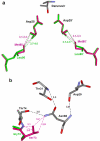HIV-1 Protease: Structural Perspectives on Drug Resistance
- PMID: 21994585
- PMCID: PMC3185505
- DOI: 10.3390/v1031110
HIV-1 Protease: Structural Perspectives on Drug Resistance
Abstract
Antiviral inhibitors of HIV-1 protease are a notable success of structure-based drug design and have dramatically improved AIDS therapy. Analysis of the structures and activities of drug resistant protease variants has revealed novel molecular mechanisms of drug resistance and guided the design of tight-binding inhibitors for resistant variants. The plethora of structures reveals distinct molecular mechanisms associated with resistance: mutations that alter the protease interactions with inhibitors or substrates; mutations that alter dimer stability; and distal mutations that transmit changes to the active site. These insights will inform the continuing design of novel antiviral inhibitors targeting resistant strains of HIV.
Keywords: aspartic protease; darunavir; drug resistance; molecular mechanism; protease inhibitors.
Figures









Similar articles
-
Structural Studies of a Rationally Selected Multi-Drug Resistant HIV-1 Protease Reveal Synergistic Effect of Distal Mutations on Flap Dynamics.PLoS One. 2016 Dec 16;11(12):e0168616. doi: 10.1371/journal.pone.0168616. eCollection 2016. PLoS One. 2016. PMID: 27992544 Free PMC article.
-
Kinetic, stability, and structural changes in high-resolution crystal structures of HIV-1 protease with drug-resistant mutations L24I, I50V, and G73S.J Mol Biol. 2005 Dec 9;354(4):789-800. doi: 10.1016/j.jmb.2005.09.095. Epub 2005 Oct 21. J Mol Biol. 2005. PMID: 16277992 Free PMC article.
-
C-5-Modified Tetrahydropyrano-Tetrahydofuran-Derived Protease Inhibitors (PIs) Exert Potent Inhibition of the Replication of HIV-1 Variants Highly Resistant to Various PIs, including Darunavir.J Virol. 2015 Nov 18;90(5):2180-94. doi: 10.1128/JVI.01829-15. J Virol. 2015. PMID: 26581995 Free PMC article.
-
Structural and thermodynamic basis of resistance to HIV-1 protease inhibition: implications for inhibitor design.Curr Drug Targets Infect Disord. 2003 Dec;3(4):311-28. doi: 10.2174/1568005033481051. Curr Drug Targets Infect Disord. 2003. PMID: 14754432 Review.
-
Darunavir: a review of its use in the management of HIV infection in adults.Drugs. 2009;69(4):477-503. doi: 10.2165/00003495-200969040-00007. Drugs. 2009. PMID: 19323590 Review.
Cited by
-
Joint X-ray/neutron crystallographic study of HIV-1 protease with clinical inhibitor amprenavir: insights for drug design.J Med Chem. 2013 Jul 11;56(13):5631-5. doi: 10.1021/jm400684f. Epub 2013 Jun 28. J Med Chem. 2013. PMID: 23772563 Free PMC article.
-
Drug Resistance Mutation L76V Alters Nonpolar Interactions at the Flap-Core Interface of HIV-1 Protease.ACS Omega. 2018 Sep 30;3(9):12132-12140. doi: 10.1021/acsomega.8b01683. Epub 2018 Sep 27. ACS Omega. 2018. PMID: 30288468 Free PMC article.
-
Design and Synthesis of Highly Potent HIV-1 Protease Inhibitors Containing Tricyclic Fused Ring Systems as Novel P2 Ligands: Structure-Activity Studies, Biological and X-ray Structural Analysis.J Med Chem. 2018 May 24;61(10):4561-4577. doi: 10.1021/acs.jmedchem.8b00298. Epub 2018 May 15. J Med Chem. 2018. PMID: 29763303 Free PMC article.
-
Phytochemicals from Plant Foods as Potential Source of Antiviral Agents: An Overview.Pharmaceuticals (Basel). 2021 Apr 19;14(4):381. doi: 10.3390/ph14040381. Pharmaceuticals (Basel). 2021. PMID: 33921724 Free PMC article. Review.
-
Correlating conformational shift induction with altered inhibitor potency in a multidrug resistant HIV-1 protease variant.Biochemistry. 2012 Oct 9;51(40):7813-5. doi: 10.1021/bi301010z. Epub 2012 Sep 28. Biochemistry. 2012. PMID: 23009326 Free PMC article.
References
-
- Weber IT, Zhang Y, Tozser J. HIV-1 Protease and AIDS Therapy. In: Lendeckel U, Hooper N, editors. Viral Proteases And Antiviral Protease Inhibitor Therapy. in press.
-
- Palella FJ, Jr, Delaney KM, Moorman AC, Loveless MO, Fuhrer J, Satten GA, Aschman DJ, Holmberg SD. Declining morbidity and mortality among patients with advanced human immunodeficiency virus infection. HIV Outpatient Study Investigators. N Engl J Med. 1998;338:853–860. - PubMed
-
- Hammer SM, Squires KE, Hughes MD, Grimes JM, Demeter LM, Currier JS, Eron JJ, Jr, Feinberg JE, Balfour HH, Jr, Deyton LR, Chodakewitz JA, Fischl MA. A controlled trial of two nucleoside analogues plus indinavir in persons with human immunodeficiency virus infection and CD4 cell counts of 200 per cubic millimeter or less. AIDS Clinical Trials Group 320 Study Team. N Engl J Med. 1997;337:725–733. - PubMed
-
- Sepkowitz KA. AIDS--the first 20 years. N Eng J Med. 2001;344:1764–1772. - PubMed
-
- Ghosh AK, Chapsal BD, Weber IT, Mitsuya H. Design of HIV protease inhibitors targeting protein backbone: an effective strategy for combating drug resistance. Acc Chem Res. 2008;41:78–86. - PubMed
Grants and funding
LinkOut - more resources
Full Text Sources

